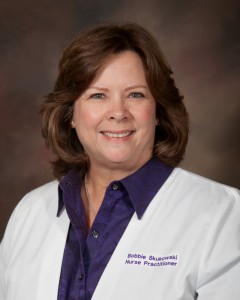Bond’s Diabetes Clinic Goes Beyond Treatment to Education
by TERESA SCHIFFER
Central Florida Health News Volume 10, Issue 8, November 2020
According to the CDC, the incidence of new diabetes cases is going down — except among young people.  The incidence of new cases among individuals under age 20 is actually going up. Data analyzed through 2018 shows that just over 10 percent of the United States’ population is living with diabetes, and that most adults who have prediabetes are unaware of their condition.
The incidence of new cases among individuals under age 20 is actually going up. Data analyzed through 2018 shows that just over 10 percent of the United States’ population is living with diabetes, and that most adults who have prediabetes are unaware of their condition.
Diabetes is not an entirely preventable disease, but there are steps that can be taken to greatly reduce a person’s risk of developing the condition, especially when it comes to type 2.
“Diabetes is a condition that is 95 percent managed by the patient. So the more they know, the better they do,” says Bobbie Skukowski, an Advanced Practice Registered Nurse and certified diabetes educator.
Skukowski is the Program Coordinator at the Bond Diabetes Clinic in Winter Haven. She works closely with the doctors and endocrinologists who treat diabetes patients, so she has some insight on how effective education can be for these individuals. The National Institutes of Health agree that Diabetes Self-Management Education is a key component to leading a healthier lifestyle for patients struggling to control their diabetes or prediabetes.
The Bond Diabetes Clinic offers a variety of services, including diabetes treatment, education, and referrals to specialists such as podiatrists. They primarily see patients who have diabetes, either type 1 or type 2, but they do also serve patients with thyroid disease.
“We have an American Diabetes Association-recognized program,” Skukowski explains. “The American Diabetes Association certifies people to teach, so we follow their guidelines. We have a dietician who sees the patient individually for at least an hour, and then we have a nine-hour class. We offer three three-hour classes for that. This is all guided by the American Diabetes Association, based on studies of what patients need to learn about when they have diabetes.”
Patients who take advantage of the classes offered by the Bond Diabetes Clinic learn how to eat healthier, lose weight, exercise, manage their medication, and cope with a chronic condition. The Diabetes Self-Management Education Classes are offered to anyone who is referred to the clinic by their primary care provider or other healthcare professional who manages their diabetes. Many insurances cover the cost of the classes, and so does Medicare, as they have come to realize that it costs less to invest in patients’ education than it does to pay for their treatment after developing the disorder.
Type 2 diabetes is the most prevalent form of the disease, with about 90 to 95 percent of diabetes patients being diagnosed with type 2. The difference between type 1 and type 2 diabetes is that individuals with type 1 do not produce their own insulin, so they must take it regularly in the form of injections. This is usually caused by an autoimmune condition that causes the beta cells in the pancreas to stop making insulin. Insulin is an essential hormone that is necessary for processing the glucose derived from the foods we eat.
Type 2 diabetics produce insulin, but their bodies have become resistant to it. In some cases, type 2 diabetes is treated with insulin, but more often than not it can be managed through proper diet and exercise. Sometimes type 2 diabetics are given insulin pills or they are injected with another hormone. A self-regulated diet makes a big difference, however, and Skukowski advises type 2 patients, “Become a carbohydrate expert, and learn how many carbs you should be getting with each meal.”
Historically, type 1 diabetes was typically diagnosed early in life, but it is now being found that type 1 can develop at any age. Conversely, type 2 has generally been associated with age and lifestyle factors, but now more children are being diagnosed with type 2 diabetes, especially those who are overweight and sedentary.
It is possible, but uncommon, for a person to have both type 1 and type 2 diabetes simultaneously. This usually occurs when a type 1 patient gains weight and becomes insulin-resistant. Type 2 diabetes tends to be an inherited trait, whereas an individual can have type 1 diabetes despite having no family history of diabetes.
In terms of intrinsic risk, the populations in the greatest danger of developing diabetes are Hispanics, African-Americans, Pacific Islanders, and Native Americans. These groups of people are the most likely to be genetically predisposed towards having insulin resistance. However, factors such as age, weight, and inactivity can increase anyone’s risk of developing the disease.
As our society becomes more dependent on technology and less physically active, it’s important to make the effort to engage in aerobic exercise. Maintaining muscle mass is shown to be integral to burning calories, controlling weight, and preventing falls. Make time for yoga, weight training, or cardio programs to reduce your risk.
 Treating you well since 1948
Treating you well since 1948 


